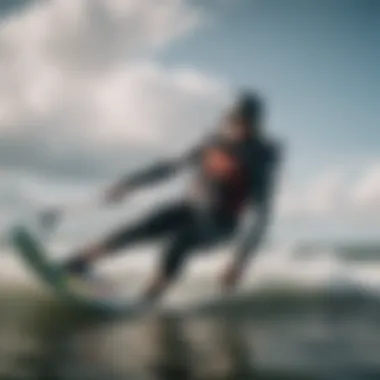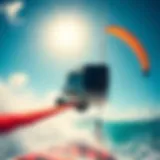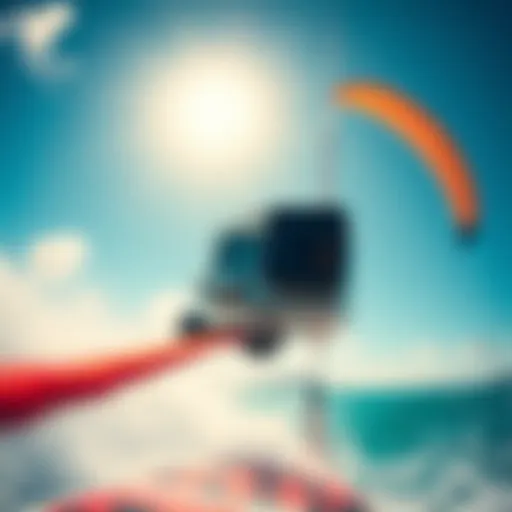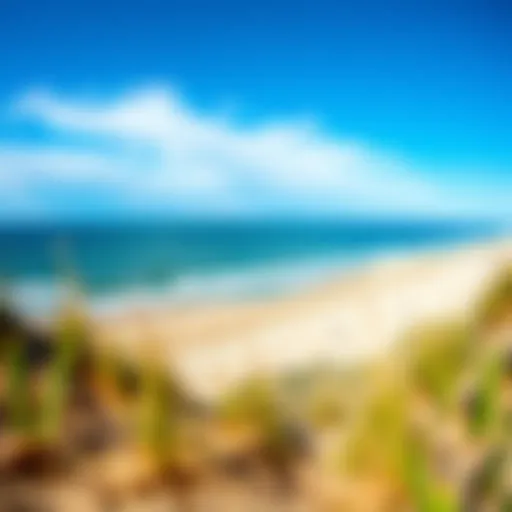Comprehensive Reviews of Kiteboarding Gear: Elevate Your Experience


Intro
Kiteboarding, where the sea meets the sky, offers an exhilarating blend of freedom and adventure. As this sport has evolved, so too have the gears that define our experience on the water. Whether you’re just starting out or have seasoned your feet in tumultuous waves, understanding the various kiteboarding gear available is crucial. This guide aims to dissect the sea of options available today—from the boards that ride the wind to the kites that lift us above the surf.
Getting the right gear isn’t just about making a choice; it’s about safety, performance, and enjoyment. Dive into this comprehensive review of kiteboarding gear, and we’ll illuminate aspects that could guide your next purchase, helping ensure that your next adventure is not only thrilling but also equipped with quality gear.
Prelude to Kite Reviews
When it comes to kiteboarding, gear quality can make or break your experience on the water. For both seasoned veterans and those just starting out, understanding the broad spectrum of available equipment is essential. This section delves into the significance of kite reviews, shedding light on intricate aspects of various products tailored to elevate your kite experience.
Importance of Gear Quality
The importance of gear quality cannot be overstated in the world of kiteboarding. High-quality equipment not only enhances performance but also ensures safety during those high-octane sessions on the water. A kite that is well-constructed and thoughtfully designed can respond better to wind conditions, giving riders the confidence to push their limits.
Several factors contribute to gear quality, including:
- Materials: Durable fabrics and robust stitching are vital, as they withstand wear and tear.
- Design: Innovative designs can improve aerodynamics, directly impacting speed and agility.
- Performance Ratings: Testing under various conditions helps gauge how well a kite handles different environments.
High-quality gear means fewer hassles and a smoother ride, which is what every kiteboarder desires. Investing in better equipment pays off as it enhances not just performance but also the enjoyment one gets while riding.
Audience Insight
Kiteboarding isn't just a pastime; it's a lifestyle for many enthusiasts. Understanding who engages with kite gear reviews is crucial for tailoring assessments. The audience can range from thrill-seeking novices on their first outings to expert instructors wanting the latest advancements for their students.
The audience typically includes:
- Kiteboarders: Individuals looking to find the right kite for their skill level and riding style, whether they’re into freestyle, wave riding, or simply cruising.
- Instructors: Professionals needing reliable and versatile gear capable of handling instructional sessions while ensuring student safety.
- Travelers and Adventurers: Those eager to find compact, travel-friendly kites without sacrificing quality. They often seek compatibility with different wind conditions and varying locations.
By tapping into the experiences and preferences of this varied audience, kite reviews can become more comprehensive. Knowing the target segments can help highlight gear qualities that align with user intentions, ultimately promoting informed purchasing decisions.
Types of Kites: An Overview
When it comes to kiteboarding, the kind of kite you choose can make or break your experience on the water. Each type of kite has its own unique characteristics, strengths, and weaknesses, which can significantly affect performance, ease of use, and overall enjoyment. Understanding these differences not only helps in making an informed choice but also ensures that riders maximize their sessions based on weather conditions and their riding style. Nobody wants to find themselves struggling with gear that doesn't suit their needs—it's like trying to fit a square peg in a round hole.
Two primary categories dominate the kiteboarding scene: foil kites and LEI kites. Grasping the distinctions between these two can elevate your game considerably and prevent unwanted mishaps. Let's break down what each type offers, taking into account various considerations that could sway your decision.
Foil Kites
Foil kites are crafted with a series of cells that inflate when in use, giving them a much lighter profile compared to their LEI counterparts. This feature enhances the kite's ability to generate lift and maintain performance, even in less-than-ideal wind conditions. Here are some of the standout features and benefits of foil kites:
- Lightweight Design: Foil kites are generally lighter, which makes them easier to handle, especially when you’re packing up to leave the beach.
- Performance in Light Winds: These kites excel when the wind isn’t exactly howling. Many riders swear by them in marginal conditions, just like a seasoned angler knowing where to cast a line.
- Stability: The design allows for remarkable stability, making them popular choices for beginners or those looking to kite in more challenging environments.
It's important to note that foil kites can have their drawbacks as well. They tend to have less depower compared to LEI kites, which means they might not be the best fit for high-wind conditions. Moreover, the learning curve can be steeper in terms of understanding their unique handling characteristics.
LEI Kites
LEI, or Leading Edge Inflatable kites, are what most people envision when they picture a kiteboarding kite. This style of kite has a leading edge that is inflated, allowing the kite to hold its shape during flight, making them extremely popular for various reasons:
- Versatility: LEI kites are multitaskers; they're suitable for a wide range of conditions and can be easily depowered, which is a boon for riders who might find themselves in variable wind conditions.
- Ease of Use: Many riders find LEI kites more user-friendly, especially in gusty or strong winds. If you’re learning the ropes or just want a dependable ride, this type of kite can provide that sense of security.
- Higher Lift: LEI kites are well-known for their ability to produce significant lift, which can be particularly advantageous when performing tricks or jumping.
However, LEI kites do present some challenges. The extra weight can make them cumbersome when it comes to packing and carrying. Also, they require periodic maintenance, like checking for leaks or punctures, which can be a bit of a hassle if you’re the forgetful type.
Ultimately, the choice between foil kites and LEI kites boils down to personal preference, riding style, and the conditions one expects to encounter on the water. Whether it’s the allure of lightweight efficiency or the familiarity of inflatable sturdiness, understanding these types of kites is an essential step in enhancing your kiteboarding adventure. Each has its place in the journey; it’s up to you to find your fit.
Kite Performance Factors
Understanding kite performance factors is crucial for any kiteboarding enthusiast. These elements significantly influence not only your enjoyment on the water but also your safety and progression in the sport. Kite performance can determine how well you can navigate the wind, manage your kite in various conditions, and ultimately perform tricks or maneuvers. Therefore, grasping these factors can help you make informed decisions when selecting the right gear.
Wind Range
The wind range of a kite is fundamentally the spectrum of wind speeds in which it can operate effectively. This factor matters because different kites have unique wind ranges—some are designed for lighter winds while others excel in strong gusts. Knowing the wind range helps kiteboarders align their experience with the appropriate equipment.


- Optimal Performance: Choosing a kite that matches the current wind conditions ensures that the kite performs at its best. A kite designed for strong winds can handle gusts better, giving you confidence while riding.
- Safety Aspect: Being out in conditions that exceed your kite's wind range can lead to difficult situations, and even accidents. Choosing wisely helps avoid these risky encounters.
- Race vs. Freestyle: If you're leaning towards competition or freestyle, get to know your kit’s wind range nuances. Competitive riders often require kites that can maintain stability and performance in very specific conditions.
Handling and Stability
Good handling and stability in a kite are like the difference between sailing a yacht and a paddleboat. A kite with superior handling will respond quickly to steering inputs, while stability ensures that the kite remains steady in unpredictable winds.
- Responsive Steering: A well-handled kite allows you to execute turns and movements smoothly, making it easier to pop off the water or make quick adjustments while riding.
- Consistent Lift: A stable kite maintains lift even in slightly turbulent conditions. This is essential for tricks or jumps, as lack of lift can lead to sub-par performance or even crashes.
- User Experience: Beginner kiteboarders tend to benefit from kites that prioritize stability, which helps build confidence. Experienced riders might prefer a more agile kite that offers finer control.
"The most important part of kite design is its ability to handle maneuvering in a range of wind conditions while maintaining stability. Without this balance, the enjoyment of kiteboarding can diminish very quickly."
Speed and Lift
The interplay between speed and lift forms the core of kite performance. Depending on the kite's design, its ability to generate lift can greatly affect the amount of speed a rider can achieve.
- Accelerated Speed: A kite designed to optimize speed will allow kiteboarders to gain velocity quickly. This is critical for advanced maneuvers and stunts, requiring higher speeds.
- Lift Capacity: Lift is essential when you want to jump or perform aerial tricks. The right kite can provide explosive lift, allowing you to reach greater heights.
- Balancing Act: Riders often find a balance between speed and lift. Some may favor a kite that hovers well at lower speeds for tricks, whereas others might lean towards those that prioritize speed for racing.
In summary, kite performance factors—wind range, handling and stability, speed and lift—play a significant role in the overall kiteboarding experience. Understanding these elements can help you choose the right equipment that suits your style, performance needs, and conditions, ultimately elevating your time on the water.
Essential Kiteboarding Gear
In the world of kiteboarding, your gear can make or break the experience. Whether you're tackling the waves or navigating flat water, understanding the essentials is key to honing your skills and staying safe. Each piece of gear plays a distinct role that goes beyond mere convenience; it can significantly affect your performance and safety out on the water.
The right equipment not only enhances your riding experience but also adds a layer of confidence for all skill levels. If you're a newcomer, knowing what gear is necessary can streamline your learning process. For seasoned riders, staying updated with the latest gear can improve finesse and efficiency.
When it comes to essential kiteboarding gear, there are three main components to focus on: control bars, harnesses, and boards.
Control Bars
Control bars are often overlooked but are vital for steering and managing your kite. These bars connect you to the kite through lines, allowing you to maneuver effortlessly, catch the wind, and control your lift. The design can vary, with options such as adjustable widths, line lengths, and even safety features that release the kite in emergencies.
"Control bars are to kiteboarding what the steering wheel is to a car. Without a good bar, it's a bumpy ride."
When choosing a control bar, consider its compatibility with your chosen kite. Not all bars work with every kite setup, so clarity on your preferences is crucial. Accustom yourself to the feel of the bar; it should be comfortable in your hands and provide precise feedback. High-quality bars are designed with safety in mind, incorporating functions like depower systems that can quickly reduce power in gusty winds, making it essential for maintaining control during challenging conditions.
Harnesses
Harnesses might not be the first thing that comes to mind when considering gear, but they are critical for comfort and stability. The harness wraps around your torso and distributes the pull of the kite across a larger area. A well-fitted harness allows you to ride for longer periods without unnecessary fatigue, as it minimizes the strain on your lower back and torso.
There are typically two types: seat harnesses and waist harnesses.
- Seat harnesses tend to be lower and are great for beginners, as they offer more support and stability.
- Waist harnesses provide more freedom of movement, making them ideal for advanced riders who favor agility in their maneuvers.
Selecting a harness involves not just size but also checking the buckles, padding quality, and material. The more comfortable the harness, the more you can focus on enjoying your ride rather than adjusting your gear mid-session.
Boards
Boards serve as your platform on the water, and they come in various shapes and sizes, each designed for different riding styles and conditions. The board you choose can profoundly impact your performance. Factors like board length, width, rocker, and flex dictate how a board reacts to speed and waves.
- Freeride boards are versatile, great for cruising and jumps.
- Freestyle boards are typically shorter, allowing for spins and tricks.
- Wave boards are narrow and designed for high-speed turns in ocean waves.
Riding a board gracefully entails more than just picking something that looks cool; it’s about understanding what you need for your specific kiteboarding style. Trusting your board is crucial, as it becomes an extension of your movements.
Investing in high-quality, suitable gear impacts more than just performance. It enhances your safety and encourages consistent improvement. In kiteboarding, where the element of nature plays a significant role, having dependable and effective gear is a game changer.
Reviewing Top Kite Brands
When it comes to kiteboarding, selecting the right brand can make a significant difference in performance and overall experience. Each brand carries a unique ethos, different manufacturing techniques, and a tailored approach to specific rider needs. Knowing about these brands helps kiteboarders, whether they are die-hard enthusiasts or just dipping their toes in, to find products that offer reliability and improved performance.
Brand Reputation
Brand reputation plays a crucial role in kiteboarding gear selection. A brand's track record often reflects its commitment to quality and innovation. Riders often seek brands that have established themselves through consistent performance and reliability in various conditions. For instance, brands like Duotone and North Kiteboarding have made names for themselves due to their dedication to both performance and customer satisfaction. The feedback from the kiteboarding community is often the most reliable litmus test for a brand’s standing.
Furthermore, choices can be swayed by a brand's association with professional athletes and events. A kiteboarder may feel encouraged to choose a brand endorsed by riders who have proven themselves at the highest levels. So, seeing names like Slingshot and Ozone in competitive arenas can certainly stir interest among consumers looking to elevate their own skills.


"Choosing a kiteboard brand is like picking a dance partner – you want one that complements your style and keeps you steady on your feet."
Product Range Assessment
A comprehensive product range is another key factor when evaluating kite brands. Brands that offer a wide array of kites, boards, and accessories cater to the diverse needs of riders. For instance, Naish stands out not only for its performance kites but also for its expansive line of boards and harnesses. This range allows individuals to find a complete setup, making life easier when selecting matching gear.
Moreover, understanding the types of products that a brand offers can greatly influence your decisions:
- Kite Options: Some brands specialize in foil kites, while others may focus on leading edge inflatable (LEI) kites, allowing riders to pick one that best suits their style.
- Accessories: Brands like Liquid Force or Airush provide additional gear that enhances the kiteboarding experience, such as control bars and safety equipment. This offers riders the convenience of having everything they need from a single brand, simplifying compatibility issues.
- Models for All Skill Levels: It's also essential for brands to offer models that cater to different proficiency levels—entry-level, intermediate, and advanced. A company like F-One, for instance, is recognized for producing user-friendly kites that still perform well for advanced riders who enjoy some thrill.
To sum up, a brand’s reputation and the spectrum of products it offers are foundational elements for kiteboarders. They not only ensure that consumers gain access to quality equipment but also facilitate a smoother, more cohesive experience from ocean to kite.
User Feedback: Insights and Experiences
User feedback serves as a compass in the vast ocean of kiteboarding gear options. Understanding the experiences of fellow kiteboarders not only provides valuable insights but also helps to shape the narrative of gear effectiveness and satisfaction. Each review, each shared story contributes to a pool of knowledge that can guide others, especially those who are still finding their way through this exhilarating sport. This section examines how user feedback can illuminate choices about kiteboarding equipment and inform purchasing decisions through shared experiences.
Survey Insights
Surveys are like the pulse of the kiteboarding community, revealing trends, preferences, and pain points encountered by riders across different skill levels. For instance, a survey conducted among 500 kiteboarders highlighted that over 70% of respondents prioritize durability when selecting kites. Such insights are crucial, as they reflect real-world use rather than theoretical specifications from manufacturers. Brands that invest in robust materials often find favor with users, enhancing their reputation among the kiteboarding enthusiasts.
Consider what this means for potential buyers: if multiple users report issues with a particular model’s stitching or the longevity of its fabric, it can steer others away from that gear, saving time and money. Moreover, these surveys also capture emotional responses to experiences. A switch in gear can drastically affect a kiteboarder's confidence and enjoyment on the water, which numbers alone might fail to fully encompass.
In addition to durability, the surveys have also highlighted the importance of ease of use. Many beginners were overwhelmed by complex setups, emphasizing the need for simplicity. A well-reviewed kite that offers straightforward assembly can make all the difference in a successful outing on the waves.
Case Studies
Delving deeper through case studies can offer a picturesque view of how specific gear performs in various conditions and under different user experiences. Let’s take the example of Sarah, an intermediate kiteboarder who decided to switch from a standard LEI kite to a higher-performance model. Her initial logic was clear; she sought enhanced lift for those smooth jumps during windy days. However, her journey took a turn when she found that her choice, while craftily designed, required a steep learning curve, proving challenging in moderate winds.
This case illustrates how personal experiences with gear can differ significantly even under the same environmental conditions. Sarah's story did not just end there—after reaching out via online forums, she discovered a community of kiteboarders facing similar challenges with their high-performance kites. Through shared strategies and recommendations, she modified her technique and learned to harness her new equipment's potential, eventually soaring to new heights—both literally and figuratively.
Another compelling case involves James, a traveling kiteboarder. He shared findings on several kites suited for packing light without compromising performance. His experiences were documented in a post on reddit.com, that broke down the pros and cons of kites from different brands, outlining specific models that functioned well in varying conditions while still being transport-friendly. His detailed accounts have helped many aspiring travelers make more informed choices about what gear to take on their adventures.
These case studies highlight that user feedback is not merely about the gear but also about the journeys kiteboarders undertake. The stories shared carry lessons on resilience and adaptation, underscoring that every piece of gear has its place, not just in the market but within the kitesurfing narrative of individual riders.
"Every kiteboarder’s tale adds a unique stroke to the canvas of kiteboarding adventure, painting a richer picture of diverse experiences and lessons learned."
By examining both the aggregate data from surveys and these anecdotal insights from case studies, one can cultivate a nuanced understanding of the kiteboarding landscape that doesn’t just inform potential purchases but enriches the entire kiteboarding journey.
Safety Considerations in Kiteboarding
When you glide over the water, it’s easy to get swept up in the thrill of kiteboarding. However, safety should always be a top priority for all kiteboarders, from first-timers to seasoned pros. Understanding your environment, your gear, and the potential hazards can significantly elevate not just your performance but also your overall experience.
Kiteboarding involves a unique set of risks, and while it’s an exhilarating sport, it's paramount to approach it with caution. Safety considerations encompass the type of gear you use, your awareness of environmental factors, and your ability to react in emergency situations. Investing time in learning about these aspects can minimize injuries and make the sport a lot more enjoyable.
Safety Gear
Having the right safety gear is essential. It’s not just about looking good on the water; it’s about protection. The basic safety gear includes the following:
- Helmet: Protects your head from crashes and impacts. Opt for one designed specifically for water sports, which offers adequate flotation and ventilation.
- Impact Vest: This piece absorbs shock during falls and keeps you buoyant. It is like wearing an extra layer of safety.
- Safety Leash: This serves as a lifeline, keeping you attached to your kite and allowing you to release it in case of emergency.
- Cutting Tool: In emergencies, being able to slice through lines can be a lifesaver. Keep it within reach while you ride.
By consistently wearing this gear, you'll be better equipped to handle any unexpected situations. However, safety gear alone isn't enough; it must be complemented by proper training and adherence to safety protocols.
Common Risks
Kiteboarding comes with its share of risks, and being aware of these can allow you to take preventive measures. Some of the common hazards include:
- Strong Wind Conditions: Underestimating wind conditions can lead to accidents. Always check weather forecasts before heading out.
- Collisions: Whether with other kiteboarders, boarders, or natural obstacles, impacts can cause injuries. Keep your distance from others and maintain awareness of your surroundings.
- Equipment Failure: Worn-out or improperly maintained gear can fail at critical moments. Regular inspections and maintenance are crucial to averting mishaps.
- Drowning Risks: While wearing a life jacket is critical, being a good swimmer also helps. Many accidents happen when riders get tangled or stuck underwater.
"Safety is not just a practice; it’s a mindset. It’s the first step toward enjoying the thrill of kiteboarding to the fullest."
Understanding these risks helps you develop a more strategic approach to kiteboarding. Awareness and preparedness can go a long way in preventing accidents and enhancing your overall enjoyment of the sport. By taking safety seriously, kiteboarders can ensure that every ride is not only fun but also secure.
Comparative Analysis of Gear


In the fast-paced world of kiteboarding, not all gear is created equal. The comparative analysis of gear provides actionable insights into various products, allowing kiteboarders to make educated choices on what to buy. It's more than just assessing which kite or board looks flashy; it’s about understanding how different pieces of equipment can affect performance, comfort, and safety on the water.
With an ever-expanding catalog of gear on the market, kiteboarders face the challenge of choosing among myriad options. The importance of a comparative analysis lies in its capacity to break down these choices into digestible segments. It helps enthusiasts sift through features, performance stats, and user feedback, which can be a real game changer in understanding what works best for different riding styles and conditions.
Additionally, looking at gear comparisons can unveil significant differences in value, helping buyers not just pick what's popular but what's appropriate for their specific needs. This approach ensures that every dollar spent contributes to an optimized kite experience. When investing in items like kites and boards, examining aspects like material quality, design nuances, and feedback from fellow riders can highlight strengths and weaknesses that might not be visible at first glance.
"In gear comparisons, every detail counts. Small differences can lead to big changes on the water."
Kite Comparisons
When evaluating kites, several factors come into play. A kite's shape, size, and design all influence how it performs under various conditions. Comparing different kites allows riders to identify which ones suit their skill level and style.
- Shape: Different shapes cater to distinct styles of riding. For instance, bow kites are known for their stability and wide wind range, while delta shapes offer better upwind performance.
- Size: The size of a kite significantly impacts its behavior with wind. Smaller kites respond quicker but may lack power, while larger kites can catch more wind but may feel cumbersome. Riders must consider their weight, the wind conditions, and their experience level when deciding on the kite size.
- Materials: The fabric and construction method can affect durability and performance. High-quality materials often mean a higher price but can be worth the investment for serious enthusiasts.
A well-rounded comparison of kites also takes user reviews into account, providing valuable insights into how these kites perform in real-world scenarios. Whether one prefers a fast and agile kite or a more stable companion, the comparative analysis can reveal options that align well with personal preferences.
Board Comparison
Just as kites vary, so too do boards, and much like kites, choosing the right board can be crucial for optimal performance. When diving into board comparisons, a few elements need scrutiny:
- Shape and Rocker: Boards come in different shapes, impacting their speed and maneuverability. Riders looking for speed might prefer a board with a flatter rocker, while those who want more control in waves may opt for a more pronounced rocker.
- Materials and Construction: A sturdy board can take quite a beating, so materials play a significant role in both durability and weight. A lighter board can enhance performance, especially for jumps and tricks, while heavier boards often provide more stability, which is beneficial for beginners.
- Fin Configuration: The way fins are arranged significantly affects a board's tracking and turning capabilities. Some boards have multi-fin systems that allow for customization based on individual preferences and conditions.
Innovations in Kite Technology
In recent years, kiteboarding has surged in popularity, thanks in part to the relentless innovations in kite technology. The advancements we’re seeing are not just about making kites look sleek or trendy; they’re fundamentally altering how enthusiasts experience the water. With more manufacturers entering the fray, competition drives them to deliver cutting-edge gear that enhances both performance and safety. Understanding these innovations can help kiteboarders—be they newcomers or seasoned veterans—make informed choices that align with their preferences and riding styles.
Material Improvements
One of the most significant developments in kite technology hinges on the materials used. Traditional kites often employed outdated fabrics that could be as tough as a two-dollar steak. Thankfully, that narrative has changed. Nowadays, kite manufacturers are using advanced materials like ripstop nylon and Dacron that are not only lightweight but also offer incredible durability.
- Ripstop Nylon: This fabric is woven in a way that prevents tears from spreading, making it less likely to fail when subject to stress. The result is a kite that can withstand the rigors of waterboarding without needing constant patchwork.
- Dacron: Known for its strength and UV resistance, Dacron is a go-to in the kiteboarding industry. Kites made from this material can endure hours in the sun without fading or degrading, extending their usable life significantly.
These materials often come with enhanced coatings that repel water, keeping the kites lighter and more efficient when airborne. So next time you’re soaking wet, consider this: the better the materials, the fewer the worries.
The impact on performance is tangible. Increased durability leads to fewer equipment failures, allowing riders to focus on honing their skills instead of nursing gear back to health. Riders have reported a marked improvement in responsiveness and a decrease in drag, all thanks to these material innovations.
Design Trends
Design isn’t just about nice colors and cool patterns. The evolution in kite designs has produced equipment that not only looks modern but performs at a remarkable level. Here are key trends emerging in kiteboarding gear design:
- Hybrid Shapes: Combining features of different kite types, many brands now offer hybrid designs that cater to a wider array of conditions. These kites capture the best attributes of both foil and LEI kites, providing versatility that allows riders to transition smoothly between various wind conditions.
- Streamlined Profiles: The design of kites has shifted towards more aerodynamic shapes. This change improves lift and reduces drag, enabling riders to achieve better speeds with less effort. Basically, a well-designed kite will get you gliding across the waves smoother than butter.
- Intuitive Control Systems: Today's kites are designed with user-friendly control systems that make setup and use intuitive. Many have adjustable settings that allow for quick on-the-fly changes, letting the user adapt easily to shifting water and wind conditions.
"The kiteboarding experience has evolved dramatically, closely mirroring advancements in technology found in other extreme sports. Each year, new designs redefine what it means to fly over water."
These trends illustrate how form follows function in the kiteboarding world. As the designs evolve, they truly cater to the needs and desires of the rider, making each session more enjoyable.
Travel Tips for Kiteboarders
Traveling with kiteboarding gear requires consideration and preparation; it’s more than just packing your stuff. Whether you're heading to a nearby beach or crossing continents for those breathtaking waves, understanding how to navigate the logistics of kiteboarding travel can make all the difference.
Kiteboarding Destinations
When it comes to picking kiteboarding destinations, some places shine like diamonds in the sun. Each spot has unique wind patterns, water conditions, and local cultures that cater to kiteboarders of all skill levels.
- Tarifa, Spain: Often hailed as the wind capital of Europe, Tarifa boasts consistent winds that suit both novices and seasoned pros.
- Cape Town, South Africa: With its stunning scenery and varied conditions, from calm lagoons to challenging ocean swells, it’s a kiteboarder's paradise.
- Hatteras, North Carolina: Known for its flat water and steady winds, this is a go-to for those looking to try their hand at tricks and jumps.
- Maui, Hawaii: Famous for its breathtaking views and reliable trade winds, perfect for those looking to combine adventure with beauty.
- Cumbuco, Brazil: Features warm waters and powerful winds, making it ideal for year-round kiteboarding.
Selecting the right destination isn't just about choosing the nearest beach. It involves evaluating local seasonality, regulatory requirements, and available amenities, like schools and rentals. Well-researched choices lead to the best kiteboarding experiences.
Transporting Gear Safely
Transporting your kiteboarding gear safely is paramount. Nothing trips up a perfect kiteboarding trip like damaged equipment. Here are some practical tips to safeguard your gear:
- Invest in Quality Bags: Use padded kite bags and board bags specifically designed for travel. They provide protection against wear and mishaps.
- Check Airline Regulations: Different airlines have varied policies on sports equipment. Make sure to check on weight restrictions and handling practices to avoid unpleasant surprises at the airport.
- Packing Tips:
- Insurance: Consider insurance for your gear. It can provide peace of mind in case of loss or damage during your travels.
- Disassemble Everything: Take apart your kite, bar, and board as much as you can. This reduces bulk and prevents damage during transit.
- Wrap Delicate Items: Use bubble wrap or clothes to cushion fragile items like your bar or control lines.
- Use Zip Ties: Consider using zip ties to ensure everything stays secure in transit. A little foresight can save a lot of headaches.
"Preparation is the key to an enjoyable kiteboarding experience. Take the time to plan every detail, from your gear's safety to your trip itinerary."
In summary, properly planning your kiteboarding trips by choosing ideal destinations and safeguarding your equipment makes for a smooth, exhilarating experience on the water. Embrace the adventure with smart choices, and the rewards will be unparalleled.















